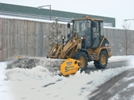
October 2011
- RISK MANAGEMENT: Can Sports Kill You?
- RISK MANAGEMENT: Improving Personal Risk Assessments
- EMPLOYEE GIFTS & INCENTIVES: Engage to Go from Good to Great
- EMPLOYEE GIFTS & INCENTIVES: Optimizing Programs Under OSHA's New Initiatives
- WORKPLACE VIOLENCE: Five Reasons Why Your People Are in Danger
- INDUSTRIAL HYGIENE: Gas Detection Programs of the Future
- ELECTRICAL SAFETY: Making Sense of Electrical PPE
- LOCKOUT/TAGOUT: Lockout/Tagout Today, Tomorrow, and Beyond
- ERGONOMICS: Little Changes Solve Big Pain Problems
- ERGONOMICS: How to Manage Ergonomics Champions at the Grassroots Level
- WINTER HAZARDS: No Business Like Snow Business
- FOOT PROTECTION: Words of Wisdom
- HEARING PROTECTION: Intelligent Hearing Protection: A Primer
- TRANSPORTATION SAFETY: Banking on Bipartisanship
- MATERIALS HANDLING: Triple Play
- MATERIALS HANDLING: Putting Real-Time Information to Good Use
- 2011 NSC PREVIEW: All Aboard for Safety
- FACILITY MANAGEMENT: Water Filtration Snuffs Dust Hazards
Click here to subscribe.
Cover Story

By Renee S. Bessette
Bottom line, it is best to find a solution that strikes the appropriate balance between hearing protection and situational awareness.
Features
By Brian Galonek
You already have many of the tools in place to achieve lofty corporate safety goals; what is needed is the spark.
By Gil Fried
Without a doubt. A total of 81 deaths in 2008 in our sector were attributable to transportation-related incidents. Workplace violence and assaults ranked second.

By Randy Strait
You can avoid the downfalls of snowfalls by hiring a reputable contractor.

By Laura Swift
Historic Reading Railroad Terminal is the site of the National Safety Congress & Expo’s long-awaited return to Philadelphia.
By Lee Marchessault, Hugh Hoagland
Remember that ignorance of these regulations will not work as a defense of an OSHA citation or when answering questions in a tort case following an electrocution.

By Jim Gaskell
Forklift fleet and operator management systems can improve warehouse operations' safety.
By Karen D. Hamel
Hazmat handlers need more than just HazCom training. Incorporating required elements from OSHA, EPA, and DOT works well.

By Ed Sullivan
Wet dust filters not only ensure regulatory compliance, but also can improve workers' comfort and production flow.

By Dawn Shoemaker
Manufacturers that make tools and equipment for use in offices and industrial settings can play a significant role in helping to minimize WMSDs.
By Jerry Laws
Jackie Gillan, president of Advocates for Highway and Auto Safety, has high hopes for increasing highway safety through the pending surface transportation bill.

By Gregg Bako
Here's a brief look into one company's gas detection program in the year 2021.
By Larry Wilson, Gary Higbee
The main risk is the person doing something unexpectedly themselves, like making a mistake. People don't evaluate that kind of risk very well or very readily.

By Jimi Michalscheck
Some companies see LOTO as a burden. But it is a competitive advantage to those willing to develop a program that is not only safe and compliant, but also highly efficient.
By Carol Fredrickson
Employees must have a clear understanding of whom to go to with a complaint and how this is to be reported. There should be no confusion.
By Jerry Laws
When a safety manager explains what PPE he or she is recommending and why, that should be persuasive, says orthopedic surgeon Dr. Gregory C. Berlet, who sees the damage a severe crush injury leaves behind.
By Sean Roark
The conflict between employers' love affair with effective safety incentive programs and OSHA’s concern that those same programs may encourage under-reporting has gone on virtually since the OSH Act became law in April 1971.
Departments
By Jerry Laws
Researchers are showing a renewed interest in studying workload factors and looking for efficient ways to evaluate it.
By Robert Pater
Malcolm Gladwell referred to "The Law of the Few" -- that it takes only a few of the right people to champion an idea that virally ignites change.